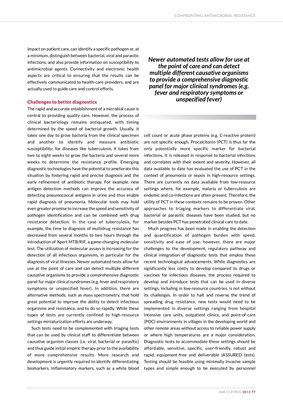
impact on patient care, can identify a specific pathogen or, at
a minimum, distinguish between bacterial, viral and parasitic
infections, and also provide information on susceptibility to
antimicrobial agents. Connectivity and electronic health
aspects are critical to ensuring that the results can be
effectively communicated to health-care providers, and are
actually used to guide care and control efforts.
Challenges to better diagnostics
The rapid and accurate establishment of a microbial cause is
central to providing quality care. However, the process of
clinical bacteriology remains antiquated, with timing
determined by the speed of bacterial growth. Usually, it
takes one day to grow bacteria from the clinical specimen
and another to identify and measure antibiotic
susceptibility; for diseases like tuberculosis, it takes from
two to eight weeks to grow the bacteria and several more
weeks to determine the resistance profile. Emerging
diagnostic technologies have the potential to ameliorate this
situation by fostering rapid and precise diagnosis and the
early refinement of antibiotic therapy. For example, new
antigen detection methods can improve the accuracy of
detecting pneumococcal antigens in urine and thus enable
rapid diagnosis of pneumonia. Molecular tools may hold
even greater promise to increase the speed and sensitivity of
pathogen identification and can be combined with drug
resistance detection. In the case of tuberculosis, for
example, the time to diagnosis of multidrug resistance has
decreased from several months to two hours through the
introduction of Xpert MTB/RIF, a game-changing molecular
test. The utilization of molecular assays is increasing for the
detection of all infectious organisms, in particular for the
diagnosis of viral illnesses. Newer automated tests allow for
use at the point of care and can detect multiple different
causative organisms to provide a comprehensive diagnostic
panel for major clinical syndromes (e.g. fever and respiratory
symptoms or unspecified fever). In addition, there are
alternative methods, such as mass spectrometry, that hold
great potential to improve the ability to detect infectious
organisms and resistance, and to do so rapidly. While these
types of tests are currently confined to high-resource
settings miniaturization efforts are underway.
Such tests need to be complemented with triaging tests
that can be used by clinical staff to differentiate between
causative organism classes (i.e. viral, bacterial or parasitic)
and thus guide initial empiric therapy prior to the availability
of more comprehensive results. More research and
development is urgently required to identify differentiating
biomarkers. Inflammatory markers, such as a white blood
cell count or acute phase proteins (e.g. C-reactive protein)
are not specific enough. Procalcitonin (PCT) is thus far the
only potentially more specific marker for bacterial
infections. It is released in response to bacterial infections
and correlates with their extent and severity. However, all
data available to date has evaluated the use of PCT in the
context of pneumonia or sepsis in high-resource settings.
There are currently no data available from low-resource
settings where, for example, malaria or tuberculosis are
endemic and co-infections are often present. Therefore, the
utility of PCT in these contexts remains to be proven. Other
approaches to triaging markers to differentiate viral,
bacterial or parasitic diseases have been studied, but no
marker besides PCT has penetrated clinical care to date.
Much progress has been made in enabling the detection
and quantification of pathogen burden with speed,
sensitivity and ease of use; however, there are major
challenges to the development, regulatory pathway and
clinical integration of diagnostic tests that employ these
recent technological advancements. While diagnostics are
significantly less costly to develop compared to drugs or
vaccines for infectious diseases, the process required to
develop and introduce tests that can be used in diverse
settings, including in low-resource countries, is not without
its challenges. In order to halt and reverse the trend of
spreading drug resistance, new tests would need to be
implemented in diverse settings ranging from hospital
intensive care units, outpatient clinics, and point-of-care
(POC) environments in villages in the developing world and
other remote areas without access to reliable power supply
or where high temperatures are a major consideration.
Diagnostic tests to accommodate these settings should be
affordable, sensitive, specific, user-friendly, robust and
rapid, equipment-free and deliverable (ASSURED tests).
Testing should be feasible using minimally invasive sample
types and simple enough to be executed by personnel
CONFRONTING ANTIMICROBIAL RESISTANCE
AMR CONTROL 2015 77
Newer automated tests allow for use at
the point of care and can detect
multiple different causative organisms
to provide a comprehensive diagnostic
panel for major clinical syndromes (e.g.
fever and respiratory symptoms or
unspecified fever)